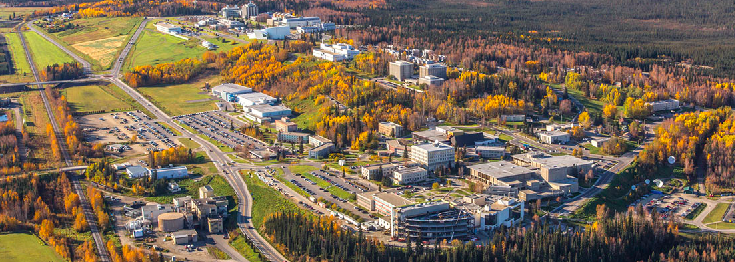BACK TO BASICS FOR PUBLIC BROADCASTING?
University of Alaska Chancellor Dan White last week outlined some of the steps the Fairbanks campus will take to meet budget cuts for that campus. The campus public broadcasting entity was a sitting duck.
Systemwide, the State of Alaska withdrew $25 million in support for the University of Alaska. The Fairbanks share of that is $12.5 million, but with some fixed costs going up and even with some across-the-board reductions, UAF still has to trim $10 million from its budget.
Unlike some other public broadcasting stations, KUAC’s employees are University of Alaska Fairbanks employees, which make them more costly than many of their public broadcasting counterparts, as they are part of the generous benefits package that comes with university employment.
” To meet the remainder, we are realizing $500k from moving some of KUAC’s expenses to private and corporate support, $2.5 million from reduced facilities maintenance, and $700k from research; the balance will be met through reserves and sales of land and facilities,” Chancellor White explained in his weekly budget update at the school’s website.
That means KUAC is going to have to depend on more corporate support from the community, and look to local philanthropists. It might try other strategies as well to reduce costs.
Last month, KUAC announced it would eliminate five of its radio and television channels in October, in response to the cuts, which also include a $144,539 line item from the Alaska Public Broadcasting System, which was zeroed out by the Dunleavy Administration.
Discontinued channels included the one that broadcasts 360 North. Digital radio channels KUAC 2 and KUAC 3 were also shut down.
Between the two cuts, KUAC lost 17 percent of its overall $2.9 million operating budget.
In 2016, KUAC was receiving $1.1 million from the State of Alaska through the University, and another $160,361 of public funds came through the Alaska Public Broadcasting Commission.
[View KUAC’s FY 17 budget audit here]
To compare, Alaska Public Media, based in Anchorage, received less than $400,000 from State funds in 2018, and has a more diversified base of support. The budget cut from the State this year hit the APM consortium less drastically than what KUAC is going through.
The cost drivers include KUAC’s ownership by the University of Alaska Fairbanks; while in 2018 APM had $1.13 million in salary and benefits, KUAC’s budget for salaries and benefits was $1.74 million.
[View Alaska Pubic Media’s FY18 audit here]
“These one-time actions will not solve our budget for next year, but will give us time to look at larger opportunities,” White wrote. “I don’t anticipate asking for additional across-the-board reductions to meet this uncertainty. Identifying vertical reductions will happen through our established processes.”
UAF has also started an expedited academic review, in anticipation of an additional $25 million systemwide reduction next year.
Some ideas generated earlier this year when the campus was expecting a much greater cut are still under consideration and Chancellor White asked the university community for feedback on which to consider:
- Shift selected public service and outreach functions to alternative funding streams, similar to KUAC. Consider the Mining and Petroleum Training Service (MAPTS), K-12 Outreach, Cooperative Extension Service, Marine Advisory Program, and others. None are being proposed for elimination.
- Increase private support for Athletics, transitioning off of general funds.
- Shift full-time employees to 37.5 hour work weeks, with some exclusions.
- Implement and expand shared service centers.
- Sell less well used UAF property and facilities.


Virtually all radio stations are owned by private individuals. They invest their own time and money hoping to succeed. The notable exception is public radio. Why should the government fund competition to private sector investment?
Crazy. They are eliminating 5 channels. That is good. Someone in the private should be able to get some lift, unless there isn’t any value. In which case we should find more waste to cut.
Comments are closed.